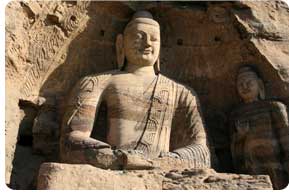 In the north of China, near to the inner Mongolia and a few hundreds kilometers away from Beijing, lies Datong, a small town from the province Shanxi, inhabited by 3 million people. Being rather small and covered by heavy layers of coal-and soot-blackened clouds, this industrial town that once during the Wei dynasty has served as capital and until some hundred years ago still as administrative town, does nowadays appear to be rather unprepossessing.
In the north of China, near to the inner Mongolia and a few hundreds kilometers away from Beijing, lies Datong, a small town from the province Shanxi, inhabited by 3 million people. Being rather small and covered by heavy layers of coal-and soot-blackened clouds, this industrial town that once during the Wei dynasty has served as capital and until some hundred years ago still as administrative town, does nowadays appear to be rather unprepossessing.
Whoever thinks so is simply mistaken, because near the town there are two of the most impressive sights of the whole region: the Yinyang Caves and the Hanging Temple.
The Yinyang Caves extend over the mountains that surround Datong with approx. one km in length. Emperors of various dynasties let chisel Buddha’s into the stone in every imaginable size, so that they seem to stand out against the stony wall in form of half-reliefs.
The largest one of the collection of more than 10.000 Buddha measures approximately 19 meters, the smallest one 2 cm. They are witnesses of different centuries and various styles of the dynasties that became immortalized there. Each of the single caves that were chiseled into the rock face is completely covered by ornaments, colorful fresco and sculptures. They are temples of prayer in the coolness of the stone and they tell stories like the birth of Buddha and other ancient legends. Many of them were destroyed during the course of the centuries, not at least thanks to the adjacent main road leading from Datong to Beijing. Until a few years ago and only a few meters away from this UNESCO world heritage site, heavy goods vehicles transported tons of coal on this road, thereby damaging the rocks and the colors bit by bit. Other Buddha-statues were destroyed or stolen. However, nevertheless the largest portion of these impressive sculptures can still be admired, many of them even with the original color still attached.
The Hanging Temple is located approx. 75 kilometers outside of Datong. Once after having successfully conquered the Serpentines, which takes approx. one hour driving by car, one will face a breathtaking panorama: 40 meters on top over the ground, built onto a steep face at the highest mountain of the surroundings, there is a temple, erected onto a gradient of 90%, looking similar to a swallow’s nest. This temple, completely built from wood with narrow corridors and small altars, has been a well known place for pilgrims, who once travelled the country.
The temple is the only of its kind in the surrounding area that unites the three religions Taoism, Buddhism and Laoism. Still today, it is carried by the same wooden buttresses that were used for building it 1000 years ago, and the way through the narrow passages of the creaking temple does still only lead into one direction, owing to a lack of space.
In any way, in the areas hidden by the mountains surrounding Datong, there is far more to discover than just industry. Even if the first impression might not suggest it instantly: Datong is certainly worth a visit.
|



